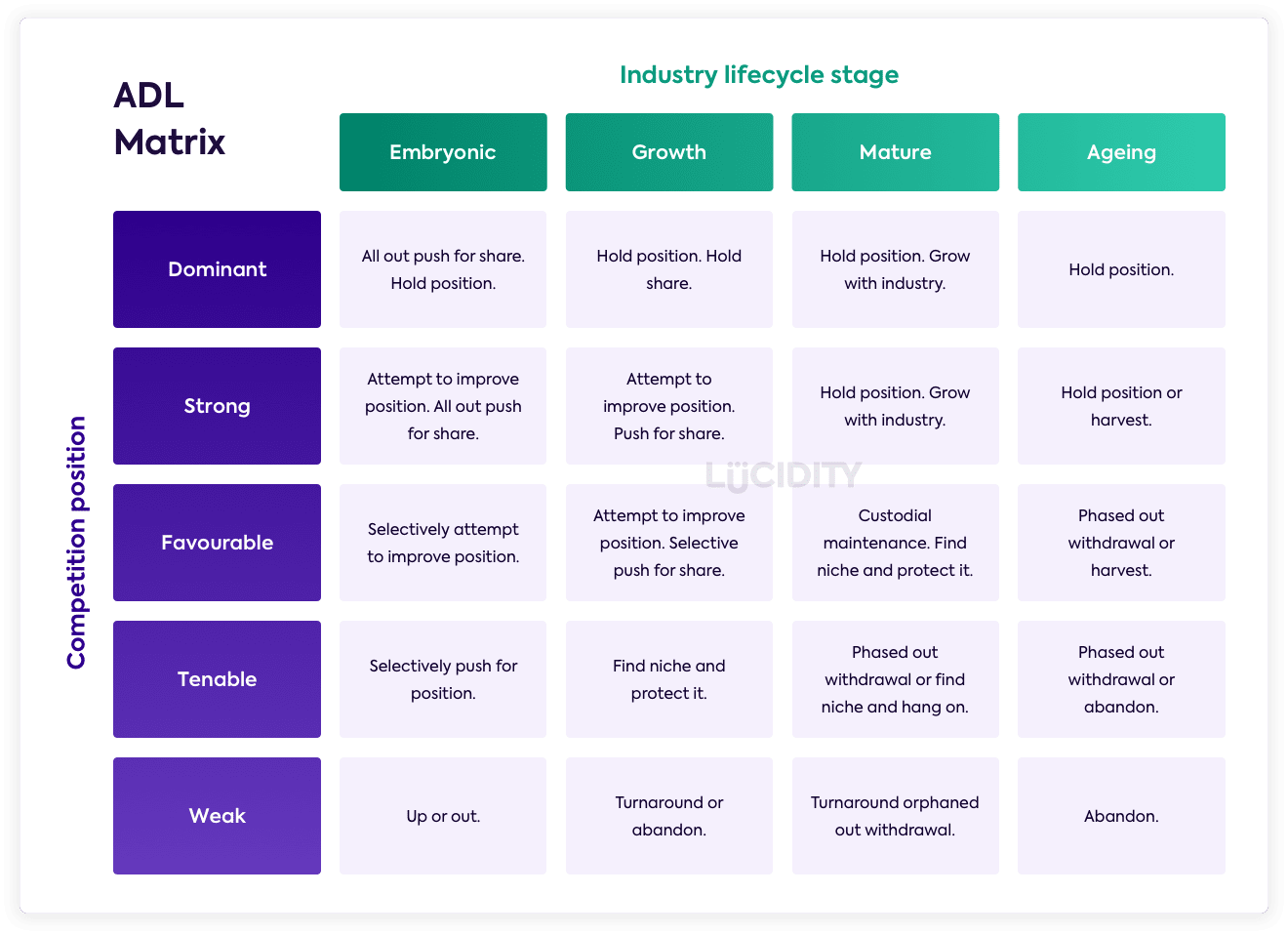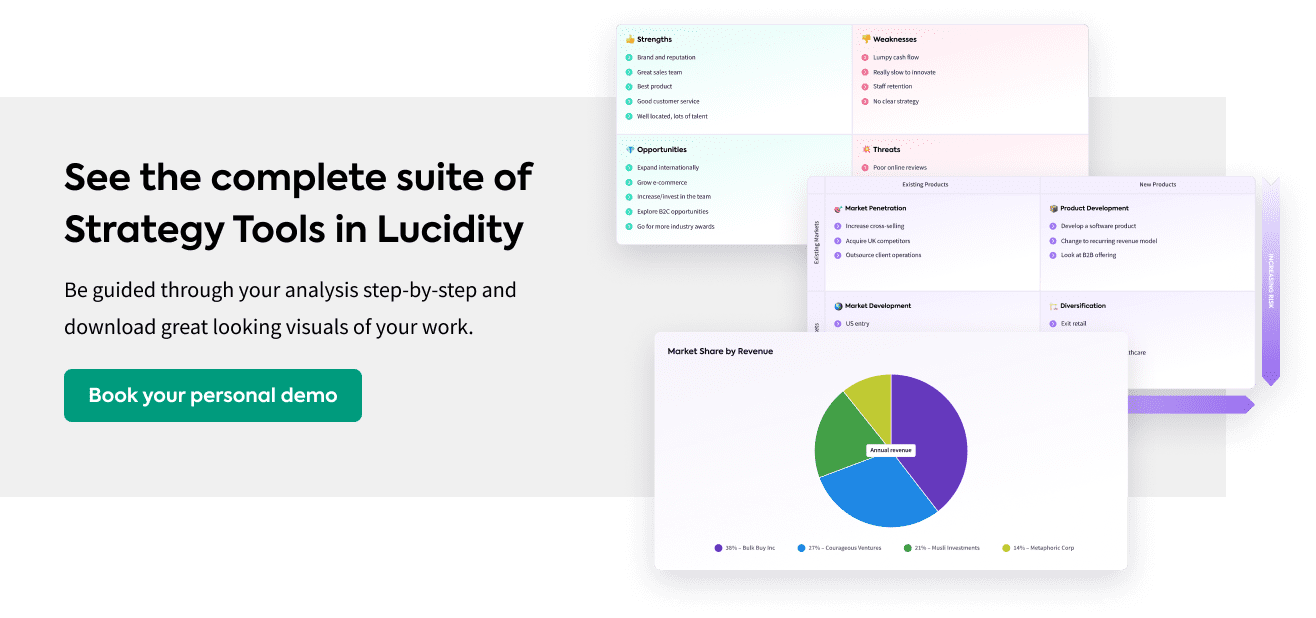Evaluating your product or service portfolio strategically can be a complicated task, so it’s useful to summarise your findings in a single diagram.
The ADL Matrix is one potential option, often used in a Product Strategy or a Company Strategy. You may have heard of it under another name – the Strategic Condition Matrix!
What is an ADL Matrix?
The ADL Matrix (or Strategic Condition Matrix) allows you to manage your portfolio by making judgements around the overall market and industry life cycle, along with your own placement within that market. It can be a quick tool for creating a list of your products.
The industry is classified as:
- Embryonic
- Growth
- Mature
- Aging
Read: https://getlucidity.com/strategy-resources/the-2×2-matrix/
The competitive positions are classified as:
- Dominant
- Strong
- Favourable
- Tenable
- Weak
When combined, these two classifications provide you with 20 possible positions for you to place your current or future products and services.
What are the business strength measurements in an ADL Matrix?
There are 5 business strengths in the ADL matrix called Dominant, Strong, Favourable, Tenable, and Weak. Deciding which you are for each product or service depends on a few factors…
Dominant
You are market leader and have a strong market position, there’s little competition that can reach you at the moment.
Strong
You have a good market share, perhaps you’re leader or number 2, and you have a number of trends in your favour (eg customer loyalty). Competition may be present but is not a huge concern.
Favourable
You have some market share but there may be many competitors with equal or similar shares, it’s much harder to be unique or you’re struggling to establish your position, but the industry can sustain you.
Tenable
You’re in a niche or small market, perhaps geographical or defined by the product and service itself.
Weak
Things aren’t going well – it’s not profitable, you’re losing market share, or you’re struggling to operate within the market.
How are the lifecycle stages in an ADL Matrix defined?
There are 4 industry lifecycle stages in the ADL called Embryonic, Growth, Mature and Ageing.
Embryonic
Very early in the market development, you’re seeing rapid growth and there’s likely not much competition.
Growth
The market is maturing but still growing at a good rate, you may find more competitors than before but it still has substantial development for you.
Mature
Everything is stable and there may be some growth, but you’re no longer seeing the rapid rise of the previous stages. There are established competitors with industry maturity now playing in the market and the barrier to entry is higher than beforehand.
Aging
Your market and market position are in decline, there’s less need for the product or service and price is being reduced. Competitors may diversify or exit the market.
What are the advantages of an ADL Matrix?
There are a number of advantages to the ADL Matrix:
- It’s detailed enough to be quite specific
- It conveys a lot of information in one easy diagram
- Conclusions are easy to draw from it
- It provides a nice way to map your entire portfolio in one image
- It’s easy to use
- The discussions generated are often of high value
- It can help find opportunities to enhance your competitive advantage
What are the limitations of an ADL Matrix?
The ADL has a few limitations such as:
- Aspects of the model are subjective, such as the industry lifecycle
- Competitive movements can impact the analysis
- It can be time consuming
- The model can be out of date relatively quickly
What preparation should be done to complete an ADL Matrix?
It is required to have knowledge of:
- Your existing products/services
- Their financial performance and contribution
- Awareness of the markets you operate in and the latest trends
It’ll help if you also have information on:
- Current client relationships
- Example good case studies of sales and service
- Example bad case studies of sales and service
- Latest news in your sector
- Any competitive activity your aware of
- Your client’s current competitive position
- Employee feedback on products/services
If in a group, these can be shared via an email beforehand or presented on the day.
Who invented the ADL Matrix?
The ADL Matrix was invented by the firm Arthur D Little in the 1970s. It offers a powerful approach to help you assess whether your current portfolio management method can be improved and also to analyse an organisation’s competitive position.
What is the difference between the ADL Matrix and the Strategic Condition Matrix?
Nothing – these are two names for the same matrix!
Should you complete the ADL Matrix in a group?
You’ll get better results if you work as a team, either physically or virtually, but it’s not a requirement. Teamwork may help you achieve much more rapid market growth and solidify your strategic business unit more effectively than working alone.
This can be more time-consuming however, as the subjective nature of deciding where products and services sit within the matrix lends itself to being a model that causes debate.
How often should the ADL Matrix be updated?
It is best practise to review your ADL Matrix on a quarterly basis, as it can be impacted by external forces out of your control. Sales trends, consumer behaviour and competitor activity can alter the placement of products and services within the matrix. A regular review ensures you take into account of your changing landscape.















